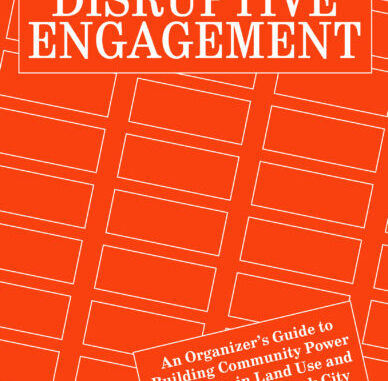
By Daniel Afanasyev
The Ethyle R. Wolfe Institute for the Humanities at Brooklyn College and the Center for the Humanities at the CUNY Graduate Center hosted “The Future of New York City: Who Decides?” on Monday, March 18. This was the third in a five-part series celebrating recent books by BC faculty. The conversation focused on the role of community organizing in the fight for a more fair and sustainable vision for local neighborhoods and the city as a whole.
The conversation was moderated by Naomi Schiller, an anthropology professor at BC and organizer for the Professional Staff Congress (PSC), and Vanessa Thill, an artist and organizer with the group Art Against Displacement, which fights against gentrification in Chinatown and the Lower East Side.
The book, “Disruptive Engagement: An Organizer’s Guide to Building Community Power for Justice in Land Use and Housing in New York City,” co-authored by Schiller and Thill, discussed how to meaningfully engage and disrupt the official community engagement processes to bring about justice in housing and land use.
“We were all in our separate neighborhoods, siloed and fighting rezoning, but we weren’t connected to each other or to our broader movement of people fighting for housing justice and healthy communities […] I felt like there was this need to connect and document all the knowledge that people had and experiences they had gained through their fights,” Schiller said.
Guest speakers and contributors to the book included Julia Bryant, an organizer with the Brooklyn-based group Movement to Protect the People (MTOPP), and Jenny Dubnau and Memo Salazar from the Western Queens Community Land Trust (WQCLT).
The book drew on the experiences and knowledge documented by Schiller and Thill through a collaborative oral history project with organizers from across NYC. Drawing on the different experiences of organizers in places like Sunset Park, Gowanus, Inwood, the Lower East Side, and more, the book provides practical advice on navigating the official channels available to the public to influence the city’s land use decisions.
“It has become very clear to us that people who are fighting these specific plans in different neighborhoods really needed to link up a little bit more to get together on how to fight back,” Thill said.
Schiller and Thill paired organizers from across the city to foster relationships through conversation and the discussion of different tactics for affecting change within this framework.
“Organizers don’t think of themselves as experts in this or people with opinions that should be taken seriously, so one of the major aims of the project was to endow each other with legitimacy in our understandings of these power dynamics,” Thill said.
Behind their approach lay the idea of “non-reformist reform,” which are reforms that challenge conditions that presently surround activists and pave the way for more revolutionary changes within the existing framework.
“We’re talking about how to organize for change within this capitalist market-driven housing system and this really unaccountable local democratic decision-making system in ways that could weaken the system and allow for more radical demands for housing and land use to come through,” Schiller said.
At the center of the many rezoning and development fights going on across the city is Mayor Eric Adams’ “City of Yes for Housing Opportunity,” a reform in the city’s zoning laws that would significantly streamline the process for developers to build more housing. According to Salazar, the proposal would result in the construction of largely market-rate housing and not the truly affordable housing that is desperately needed. It would also change the dynamics of development and give developers carte blanche into developing in every community without consulting its residents.
One tool advocates can use is the Uniform Land Use Review Procedure (ULURP), which is one of the last remaining official community engagement apparatuses still employed by the general public for influencing land use decisions by the city. Organizers highlighted the dilemma in using decision-making processes like this, as it still maintains the status quo of the city’s preferred development plans. However, the speakers also emphasized that its existence is still better than its non-existence.
“Although it is a love-hate thing, we hate it because it is rigged,” said Dubnau. “But on the other hand, at least it is a chance for the community to weigh in.”
More information on “Disruptive Engagement: An Organizer’s Guide to Building Community Power for Justice in Land Use and Housing in New York City” can be found at: https://centerforthehumanities.org/programming/disruptive-engagement
